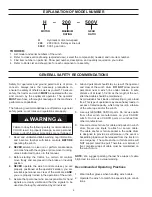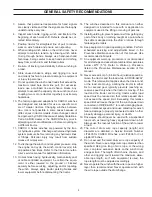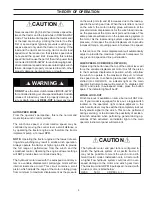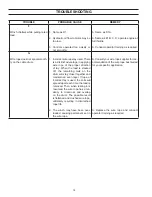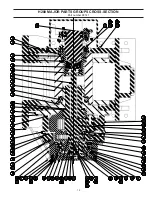
9
AUTOSPEED MODE
From the operator’s perspective, this is the normal and
most simple winch control method.
The winch line speed, or drum rotation speed, may be
controlled by moving the control lever a small distance or
by operating the tractor engine, and therefore the tractor
implement pump, at a lower RPM.
NOTE:
Operating the tractor engine at the lowest idle set-
ting while winching may result in erratic winch operation.
Always operate the tractor at high engine idle to provide
the full range of performance from the winch and the
smoothest control. Operating the engine at lower settings
will NOT provide slower controlled winching.
The hydraulic motor used with the autospeed control sys-
tem is a variable displacement, piston-type motor with an
internal load-sense circuit. This circuit contains a small
piston which adjusts the angle of the motor rotating group
from minimum to maximum displacement as the pressure
THEORY OF OPERATION
on the work ports (A and B) increases due to the load ap
-
plied to the winch gear train. When there is little or no load
on the winch, the motor rotating group will remain at the
preset minimum displacement. As the winch load increas-
es, the pressure at the motor work ports will increase. This
same pressure will also act on the load-sensing system in
the motor. As the load-sensing system experiences more
pressure, it increases the motor displacement to provide
increased torque, or pulling power, at a slower line speed.
In this manner, the motor displacement will automatically
adjust to provide the maximum hydraulic horsepower for
any given line speed and line pull situation.
LOW-SPEED LOCK MODE (LOW LOCK)
Depressing the button near the top of the control lever will
force the variable displacement motor to shift the piston
to the maximum displacement position, which will allow
the winch to operate in the maximum line pull, minimum
line speed mode, to enhance precise load control. When
shifted into LOW-LOCK, an indicator light on the main
operator instrument panel will remain lit. To disable LOW
LOCK, and return to autospeed mode, press the button
again. The indicator light will be off.
WINCH LOCK-OUT
Winch lock-out is available on some but not all CAT doz-
ers. If your model is equipped for lock-out, a toggle switch
located on the operator’s right console adjacent to the
winch control lever may be switched to completely lock out
the hydraulic signal to the winch. This can be performed
during servicing, or to eliminate the possibility of acciden-
tal winch actuation when performing general dozing op-
erations. When activated, an indicator light on the main
operator instrument panel will remain lit.
DO NOT
use the drum clutch release (DRIVE-AWAY)
for controlled reeling out of suspended loads. Sudden
release of a load may result in property damage, in-
jury, or death. Use only
REEL-OUT
to lower any load.
!
WARNING
!
Never exceed
4 mph (6.4 km/hour)
relative speed be-
tween the tractor and the load while in DRIVE-AWAY
mode. This relative limit applies when the tractor and/
or the load are moving. Limiting the tractor to either
first or second gear typically prevents reaching ex
-
cessive speed only when the tractor is moving. If the
load and the tractor are moving, tractor and/or load
speed must be reduced so that relative speed does
not exceed the speed limit. Exceeding this relative
speed limit will cause the part of the winch power train
connected in DRIVE-AWAY to reach damaging back-
driven rotational speed and cause catastrophic winch
failure, damage to property connected to winch, other
property damage, personal injury, or death.
CAUTION
!
!
The hydraulic motor and gear ratio is configured to
match the hydraulic system of a specific tractor. It
may not be possible to mount the winch onto a dif-
ferent tractor model. Installation onto a tractor with
a higher flow hydraulic system could result in over
-
speed damage to the motor and winch gear train.
The maximum drum RPM in autospeed, no-load, with
a piston motor, is listed below:
H200 500:1 9 RPM (+0, -1)
CAUTION
!
!




